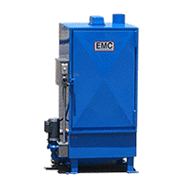Powerjet®
Spray Jets & Parts Washers
Most industrial automatic parts washers use either fan style spray jets or straight stream spray jets. What's the difference? Let's suppose you are at home hosing down your driveway when you come across something difficult to remove. Most of us would simply adjust the nozzle to switch from the weaker, but wider, fan spray to the concentrated high impact straight stream.
This example demonstrates how a fan style jet has a wide coverage area but requires high PSI to generate much impact force. Furthermore, if the distance to the target increases without the PSI increasing, the fan style jet acts more like a mister as much of the impact force is lost to air resistance. Increasing PSI using larger horsepower pump motors will improve cleaning efficiency but can lead to other problems. Fan style spray jets under high pressure can induce air currents and blow around delicate parts. Also, since the fluid leaves a fan style jet in the shape of a "V", and parts washers need the coverage of several fan jets, the best cleaning is at a distance exactly where the "V"s meet. Too close to the fan jet and some areas are left in an untouched dead zone. Too far away and much of the impact is lost as the spray from adjacent jets collide. In addition, the unusable dead zone before the fan jets converge requires a larger washer cabinet for the same size wash load. To overcome these problems, some fan jet parts washer designs use adjustable or rotating wash manifolds.

The straight stream jet design has a high impact force at varying distances since the area being targeted is small. Good coverage requires many straight jets at close spacing. This calls for high GPM flow rates and larger plumbing to accommodate all the jets needed. Since the distance to the target is less critical, moving or adjustable manifolds are unnecessary. Also, because the straight stream pierces the air rather than pushing it, parts are less likely to be blown around, thus reducing the need for special racking.
The high PSI necessary to operate fan-jet style parts washers requires high horsepower pump motors. Being under high pressure, the motors, pumps, and seals on these units are more likely to fail and need replacing. The high volume, low pressure design of the straight stream parts washer does not require large expensive motors and the low pressure ensures a long life on system components.
The plugging up and subsequent cleanout of the jets is another significant factor in the efficient operation of parts washers. In a fan-jet type washer, the loss of a single fan jet leaves a large unwashed area. The close spacing and a large number of straight stream jets minimize the effect of the loss of a jet. In addition, cleanout of straight stream jets is relatively easy. Simply use a piece of wire, push the obstruction back into the manifold, remove the manifold cleanout port, and turn on the pump. To unplug a fan-jet normally requires the jet to be unscrewed, cleaned, and reattached.



